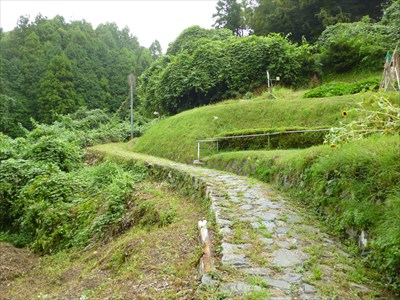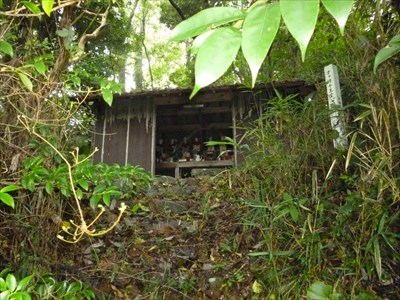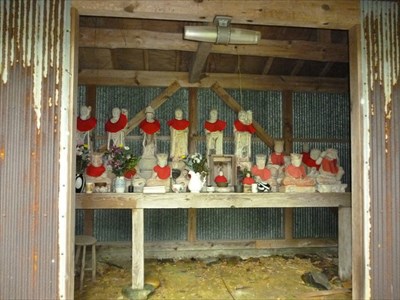| Home>Myth>Article |
The snake of Saigato Pass
The following text is a slightly modified machine translation and may have some unnatural parts.
==Genius Loki==
The word power spot seems straightforward and I hate it honestly, but what about Genius Loki? Is it good in Latin?
According to the dictionary on the net, Genius Loki is mainly used in modern times as "atmosphere of the land", and it seems that the spiritual usage is not so much. Is it the influence of Christianity? Rather, it is interesting that it is used in a form inspired by the original meaning in the game genre.
I remember that it was Yujiro Nakamura's "Glossary" that knew the word Genius Loki. It was when I was a student.
When I returned home, I visited a pass called Saigato in Shimokou town, Hamada City. It is officially read as "Saigatao", but locals call it "Saigato". On the way, there was a small shrine dedicated to Sai-no-Kami (Dosojin: the travelers' guardian deity), but my memory was confused, and I went inside thinking that it was such a place.

Cobblestone road at Saigato Pass
The cobblestone path leading to Saigato Pass was part of the Miyoshi road during the Edo period. It used to be a bad road, but it is said that it was made by a Buddhist priest Konzan of Ryuunji Temple in Misumi Town during the Bunka era by promoting people in the vicinity.
There was a small shrine dedicated to Sai-no-Kami and the Juou-do (a temple dedicated to the hellish Enma [Yama] and his followers). I noticed this later, but I was confusing the Juou-do with Sai-no-Kami. The sign built by the Board of Education states that Sai-no-Kami originally worshiped an old tree and built a small shrine because the old tree died. The Buddhist Juou-do and the Shinto small shrine are lined up.
At Juou-do of Saigato, it is said that Great Enma (Yama) checks the behavior of the dead in the Netherworld and decides the weight of the crime. Including the Great Enma, the ten kings and their followers, the Holy Kannon (Avalokitesvara), and the stone statues of Six Jizo (ksitigarbha) are housed here.

The Juou-do

The Juou-do
The small shrine of Sai-no-Kami was a little high, and when I tried to climb the bank to see it nearby, there was a snake. It looks undulating and does not try to escape even if it notices my existence. It's a pit viper.

The small shrine of Saigato
Sai-no-Kami's small shrine used to enshrine a large pine tree as an object of worship, but it is said that it was replaced by a small shrine built beside it because it died. It is said that it is the only place in Hamada City where Sai-no-Kami is enshrined.
I remembered that my father said that the pit viper was not afraid to see people. At that time, it seemed rather intimidating, and I turned back a lot. I wish I had taken a picture.
It was mentioned in the online dictionary that Genius Loki in ancient Rome was a guardian spirit of the land and often looked like a snake, but that snake may have protected Sai-no-Kami. The snake simply insisted on his territory, but I was hesitant to take pictures. Rather, it may have been better to notice at that point.
I read Takatoshi Ishizuka's "Establishment of the Sae-no-Kami Faith". This is an article about Sai-no-Kami faith. Then, is it characteristic that Sai-no-Kami of Hamada City Saigato Pass is enshrined together with the Juou-do, which enshrines the followers of Enma in hell in Buddhism? In that sense, it does not simply represent the boundary, but also the boundary between life and death.
==Digression==
The cobblestone road of Saigato faces National Road No. 9, and there is a lot of traffic, so it is dangerous to visit directly. From Route 9, head toward Kamikou town and go down Kamiarizaka slope. Then cross the railroad crossing and enter the cemetery on the Kamikou side. Then you can park your car in the parking space (sorry, manager) and walk up the old San-in-Do from there.
My father used to say that it was the old San-in-Do road, but according to the City Board of Education, it is the Miyoshi road.
I currently live in Yokohama, but there is a small shrine on the banks of the Hayabuchi River that runs through the city. I wondered why it was in such a place, but when I thought about it, the river itself was the boundary.
==References==
- * 「サエノカミ信仰の成立」「顧みる八十余年―民俗採訪につとめて―」(石塚尊俊, ワン・ライン, 2006)pp.61-90 ※「山陰民俗」34号に収録